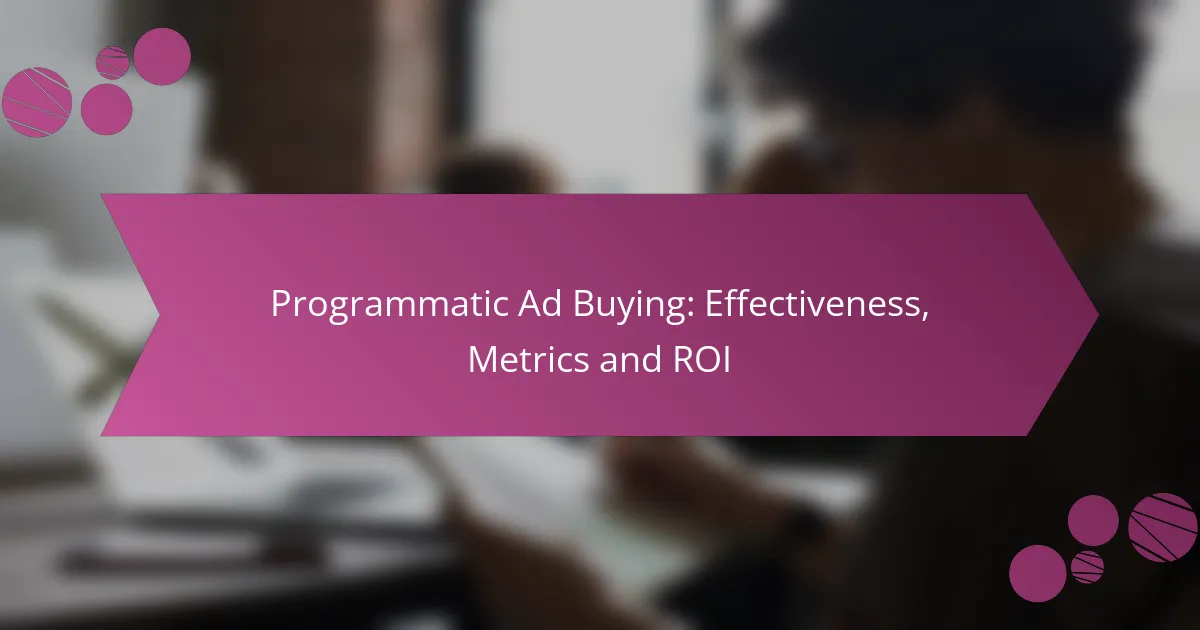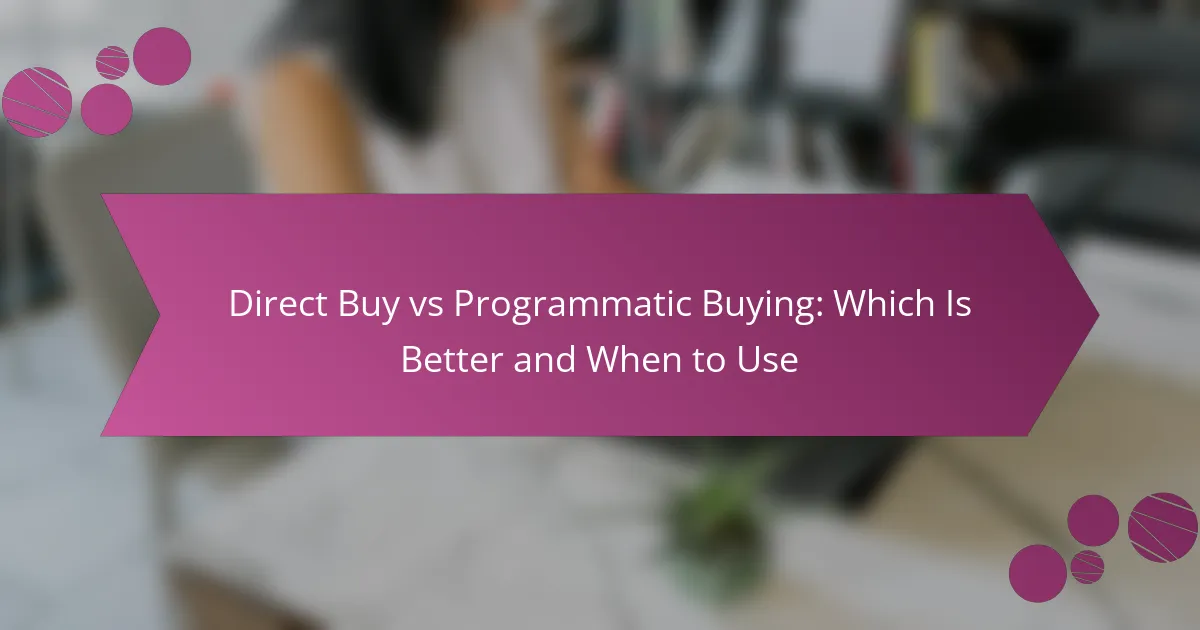Programmatic ad buying revolutionizes the advertising landscape by enabling advertisers to target specific audiences with remarkable precision and efficiency. Utilizing automated technology, this approach streamlines the purchase of digital ad space, leading to enhanced engagement and improved return on investment (ROI). Key metrics such as click-through rate (CTR) and return on ad spend (ROAS) are essential for evaluating the effectiveness of these campaigns and optimizing ad performance.

How effective is programmatic ad buying in Ireland?
Programmatic ad buying in Ireland is highly effective, offering advertisers the ability to reach specific audiences with precision and efficiency. This method leverages automated technology to purchase digital advertising space, resulting in better engagement and improved return on investment (ROI).
High ROI compared to traditional methods
Programmatic ad buying typically yields a higher ROI than traditional advertising methods, such as print or TV. This is largely due to its data-driven approach, which allows for real-time adjustments and optimizations based on performance metrics.
Advertisers can expect ROI improvements in the range of 20-50% when switching from traditional to programmatic methods. This efficiency is achieved by minimizing wasted ad spend and targeting only relevant audiences.
Increased targeting precision
One of the key advantages of programmatic ad buying is its increased targeting precision. Advertisers can utilize extensive data sets to identify and reach specific demographics, interests, and behaviors, ensuring that ads are shown to the most relevant users.
For example, a campaign targeting young professionals in Dublin can be tailored to reach users based on their online activity and preferences, rather than relying on broad audience segments. This level of targeting can significantly enhance engagement rates and conversion potential.
What metrics should be used to measure programmatic ad success?
To measure programmatic ad success, key metrics include click-through rate (CTR) and return on ad spend (ROAS). These metrics provide insights into engagement and the financial effectiveness of advertising campaigns.
Click-through rate (CTR)
Click-through rate (CTR) is a crucial metric that indicates the percentage of users who click on an ad after seeing it. A higher CTR generally suggests that the ad is relevant and engaging to the target audience. Typical CTRs for programmatic ads can range from low single digits to around 5% depending on the industry and ad placement.
To improve CTR, focus on creating compelling ad copy and visuals that resonate with your audience. A/B testing different versions of your ads can help identify which elements drive higher engagement. Avoid overly complex messages that may confuse potential customers.
Return on ad spend (ROAS)
Return on ad spend (ROAS) measures the revenue generated for every dollar spent on advertising. A ROAS of 4:1, for example, means that for every $1 spent, $4 in revenue is generated. This metric helps advertisers assess the profitability of their campaigns and make informed budget decisions.
To maximize ROAS, ensure that your targeting is precise and that your ads are shown to the most relevant audiences. Regularly analyze campaign performance and adjust bidding strategies accordingly. Avoid overspending on underperforming ads, and reallocate funds to those that yield better returns.

What are the key components of programmatic ad buying?
Programmatic ad buying involves automated processes for purchasing digital advertising space, primarily through real-time bidding and demand-side platforms. Understanding these components is crucial for optimizing ad spend and achieving better campaign performance.
Real-time bidding (RTB)
Real-time bidding (RTB) is a method of buying and selling online ad impressions through instantaneous auctions. Advertisers bid for ad space in real-time as users visit websites, allowing for highly targeted advertising based on user data.
RTB operates on a cost-per-impression (CPM) basis, where advertisers set a maximum bid for each impression. This approach enables advertisers to reach specific audiences efficiently, but it requires careful monitoring to avoid overspending.
Demand-side platforms (DSP)
Demand-side platforms (DSP) are software solutions that allow advertisers to manage multiple ad exchanges through a single interface. They facilitate the buying of ad inventory in real-time, optimizing campaigns based on performance metrics.
Using a DSP, advertisers can leverage data analytics to refine targeting and bidding strategies. It’s essential to choose a DSP that aligns with your campaign goals and offers robust reporting features to track effectiveness and ROI.
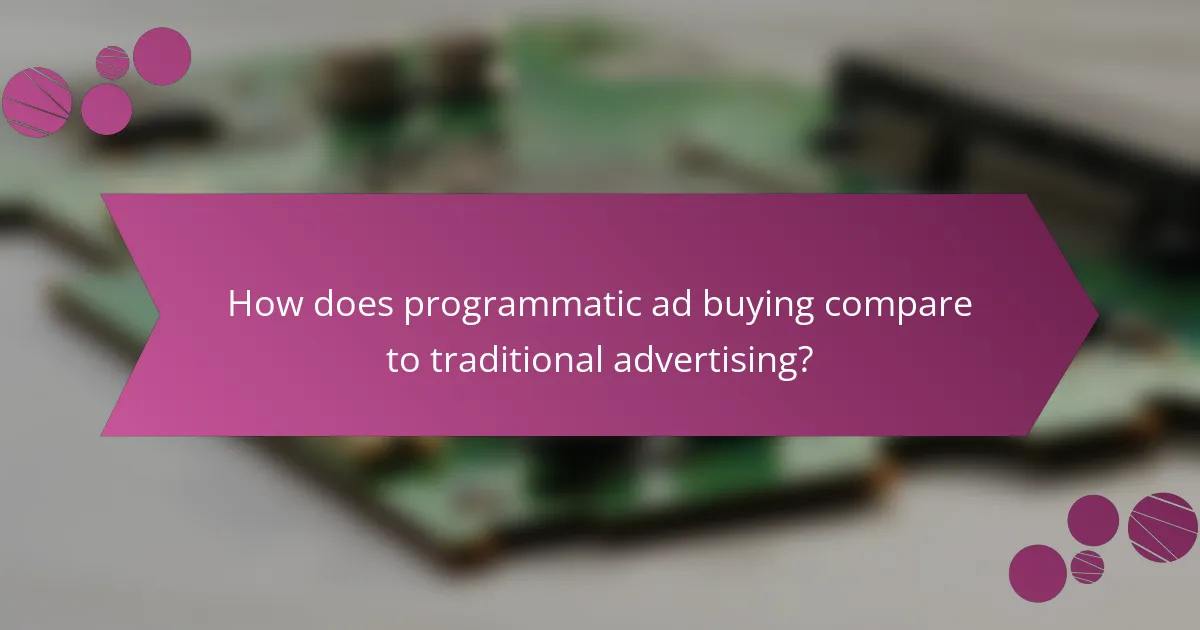
How does programmatic ad buying compare to traditional advertising?
Programmatic ad buying automates the purchasing of ad space, making it more efficient than traditional advertising methods. While traditional advertising relies on manual negotiations and fixed placements, programmatic buying uses algorithms and data to optimize ad delivery in real-time, often resulting in better targeting and cost savings.
Cost efficiency
Programmatic ad buying typically offers greater cost efficiency compared to traditional advertising. By automating the buying process, advertisers can reduce overhead costs and eliminate the need for intermediaries. This can lead to lower costs per impression and higher return on investment (ROI).
For example, programmatic campaigns can be adjusted in real-time based on performance metrics, allowing advertisers to allocate budgets more effectively. In contrast, traditional methods often require upfront payments for fixed ad placements, which may not yield the desired results.
Data-driven decision making
Data-driven decision making is a cornerstone of programmatic ad buying, enabling advertisers to leverage vast amounts of data for targeted campaigns. Advertisers can access audience insights, behavior patterns, and performance analytics to refine their strategies continuously.
This approach allows for precise targeting based on demographics, interests, and online behavior, which is often more challenging with traditional advertising. By utilizing data, advertisers can make informed adjustments to their campaigns, optimizing for better engagement and conversion rates.

What factors influence the ROI of programmatic ads?
The ROI of programmatic ads is influenced by several key factors, including audience targeting accuracy, ad placement strategies, and overall campaign management. Understanding these elements can help optimize ad spend and improve returns.
Audience targeting accuracy
Audience targeting accuracy is crucial for maximizing the effectiveness of programmatic ads. By leveraging data analytics and user behavior insights, advertisers can reach specific demographics that are more likely to convert. This precision can lead to significantly higher engagement rates and, consequently, better ROI.
To enhance targeting accuracy, consider using first-party data, such as customer lists, alongside third-party data sources. This combination allows for a more comprehensive understanding of your audience, enabling tailored messaging that resonates with potential customers.
Ad placement strategies
Effective ad placement strategies can greatly influence the success of programmatic advertising. Choosing the right platforms and contexts for ad placements ensures that your ads appear where they are most likely to be seen and engaged with by the target audience. Factors such as time of day, device type, and content relevance should be considered when planning placements.
Utilizing real-time bidding (RTB) can help optimize ad placements by allowing advertisers to bid for impressions in real-time based on performance metrics. Regularly analyzing placement performance and adjusting strategies based on data can lead to improved ROI over time.

What are the challenges of programmatic ad buying?
Programmatic ad buying faces several challenges that can impact its effectiveness and return on investment (ROI). Key issues include ad fraud risks and compliance with data privacy regulations, both of which require careful management to ensure successful campaigns.
Ad fraud risks
Ad fraud is a significant challenge in programmatic advertising, where fraudulent activities can inflate metrics and waste budgets. Common types of ad fraud include click fraud, where bots generate false clicks, and impression fraud, where ads are shown in non-viewable spaces.
To mitigate these risks, advertisers should implement verification tools and work with reputable ad networks. Regular audits of campaign performance can help identify suspicious activity and ensure that ad spend is effectively utilized.
Data privacy regulations
Data privacy regulations, such as the General Data Protection Regulation (GDPR) in Europe and the California Consumer Privacy Act (CCPA) in the United States, pose challenges for programmatic ad buying. These laws restrict how personal data can be collected, stored, and used, impacting targeting capabilities.
Advertisers must ensure compliance by obtaining explicit consent from users and providing transparency about data usage. Failure to adhere to these regulations can result in hefty fines and damage to brand reputation, making it crucial to stay informed about local laws and best practices.
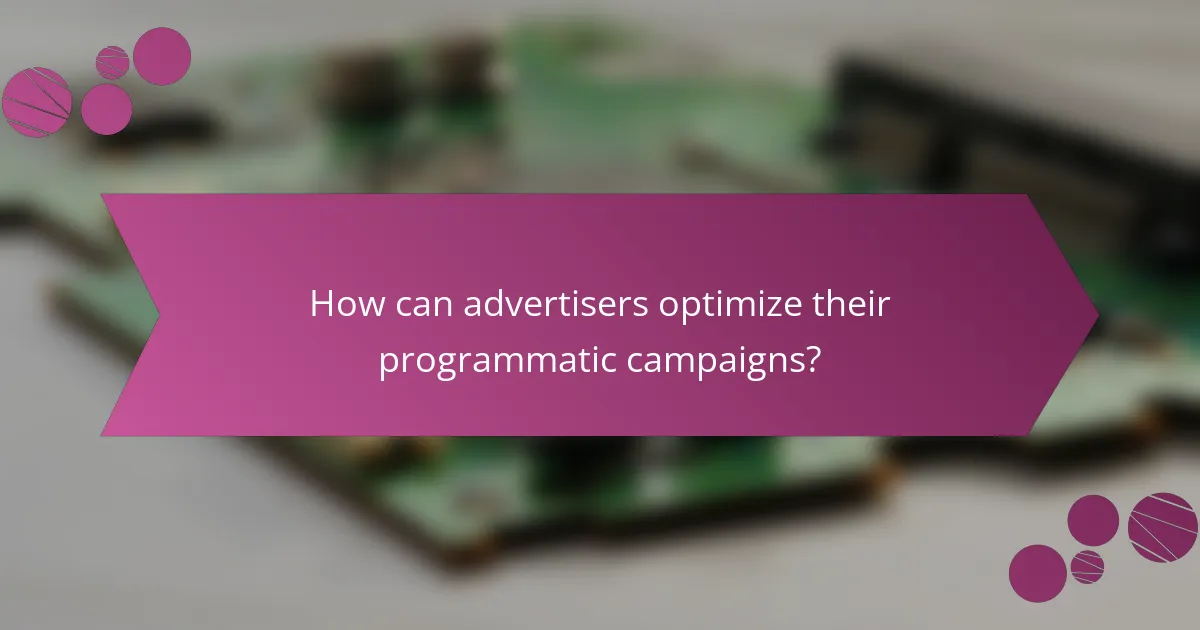
How can advertisers optimize their programmatic campaigns?
Advertisers can optimize their programmatic campaigns by implementing data-driven strategies that enhance targeting and ad performance. Key methods include A/B testing different ad creatives and utilizing analytics tools to track metrics and ROI effectively.
A/B testing strategies
A/B testing involves comparing two versions of an ad to determine which performs better. Advertisers should test various elements such as headlines, images, and calls to action, making sure to isolate one variable at a time for clear results.
To conduct effective A/B tests, allocate a portion of your budget to each variant and run the tests simultaneously to avoid timing biases. Aim for a sample size that provides statistically significant results, typically in the low hundreds or thousands, depending on the ad’s reach.
Utilizing analytics tools
Analytics tools are essential for monitoring the performance of programmatic campaigns. They provide insights into key metrics such as click-through rates, conversion rates, and return on ad spend, allowing advertisers to make informed decisions.
Popular analytics platforms, like Google Analytics and Adobe Analytics, can help track user engagement and behavior. Advertisers should regularly review these metrics to identify trends and adjust their strategies accordingly, ensuring they maximize their ROI.



